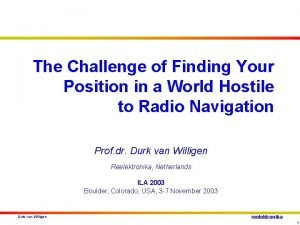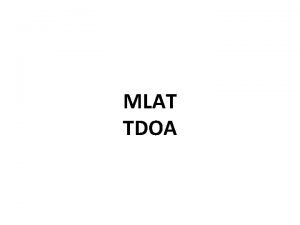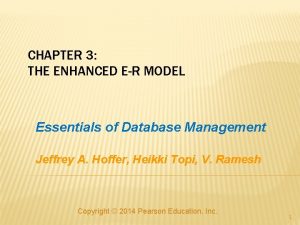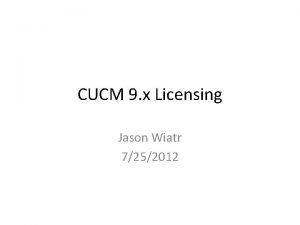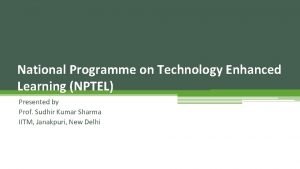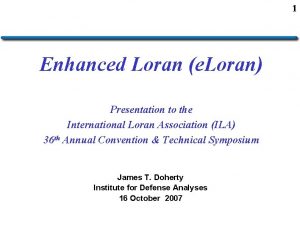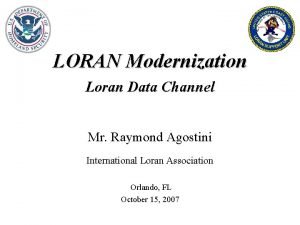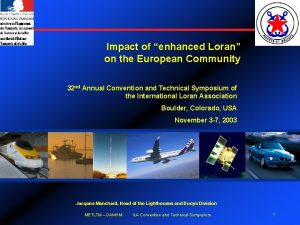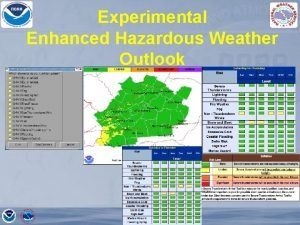1 Enhanced Loran e Loran Presentation to the











- Slides: 11

1 Enhanced Loran (e. Loran) Presentation to the International Loran Association (ILA) 36 th Annual Convention & Technical Symposium James T. Doherty Institute for Defense Analyses 16 October 2007

What This Is Not & What It Is • Not – The Independent Assessment Team (IAT) report • Is – Some perspectives on e. Loran – Request for data (way ahead) – Author’s comments 2

Why an IAT? • Panel of experts – Independent Assessment Team – From government, industry, academia, etc. – With relevant experience in senior decision-making positions • View issues from the national perspective – Not agency or user group specific • Report directly to senior sponsor(s) – Under Secretary & Deputy Under Secretary • Not a new study but a review of prior studies – – Vulnerability assessments Cost/benefit analyses Technical studies and data collection Stakeholder perspectives 3

How Did It Work? • Initial assessment: August thru December 2006 • Document review – About 40 reports, comprising 1500 -2000 pages • Three 2 -day meetings – monthly intervals – – Stakeholders (agencies & user communities) Investigators, study teams, & data collectors Industry – signal provider & user equipment Service providers – US & international • Extensive “deep dive” into cost data – Reconciliation of differences & “over bound” • Consensus conclusions & recommendations – Report to sponsors & follow up with others 4

e. Loran Defined • e. Loran – 21 st Century low-frequency (100 KHz) position, navigation, time (PNT) service – Latest evolution of LOng RAnge Navigation (LORAN) concept – Internationally standardized • e. Loran meets PNT performance requirements, including – Accuracy, availability, integrity, and continuity for applications of – – Aviation users, including non-precision approach Maritime users, including harbor entrance and approach Land mobile users, and Precise time and frequency users • e. Loran is an independent dissimilar complement to GNSS – Enables diverse user communities to continue operations when GNSS services are disrupted – Retains safety, security, environmental, and economic benefits of critical applications 5

e. Loran Is NOT Loran-C (but backwards compatible) • Upgraded infrastructure – – Solid state transmitters Modern “ensembled” time & frequency systems Uninterruptible power supplies Differential monitor network • Modernized operations concepts – Data messaging channel – differential signals, etc. – Time of transmission control – independent of GPS/GNSS – “All-in-view” signal tracking • New user equipment – e. Loran & GPS/GNSS – Digital signal processing – interoperable with GPS/GNSS – Incorporates differential signals & survey data – H-field antennas – eliminates “P-static” 6

e. Loran as Backup (& Extension) of GPS • GPS-based PNT is ubiquitous, economical, & dependency is growing in applications providing – Safety of life, economic security, quality of life • GPS (& in future GNSS) is vulnerable to disruption – Interference, atmospherics, noise floor, obstruction (urban canyons, foliage, et al), etc. • e. Loran as backup (& extension) system – – Critical PNT performance requirements Interoperable with & independent of GPS/GNSS Different failure modes – system & propagation Seamless operation for backup & also extends to GPSchallenged areas 7

e. Loran Pacing Requirements Studies & data demonstrated e. Loran meets • Harbor entrance & approach maritime navigation – 10 -20 meter accuracy – Differential monitor sites & stored survey data • Aviation non-precision approach – Required navigation performance 0. 3 nautical mile (RNP 0. 3) accuracy with – Aviation quality integrity signal • Stratum 1 frequency stability – Also met by Loran-C • 50 ns time accuracy – Traceable to Universal Coordinated Time (UTC) – Differential time monitor sites 8

e. Loran User Equipment • Nascent UE industry • Prototypes exist – Integrated e. Loran-GPS receiver designs • No one envisions standalone e. Loran design – Common user interface – Compact H-field antenna, generally integrated with GPS – Limited production reasonably available • Potential for significant cost reduction • Market surveys – Classic & new applications – “Reliable” GPS – Next equipment upgrade cycle 9

Way Ahead & Your Feedback 10 • Need for standards? – Must stop the engineering “what ifs” – Need a “Version 1. 0” standard for e. Loran • Signals in space • UE performance & testing – What is deferred until later Versions? • What is the upgrade path? For example, – For how long should e. Loran be backwards compatible for legacy Loran-C users? – Should the operating concepts be upgraded (e. g. , single -rate all transmitters); when? • What else is needed for the users to equip? – Are regulations or incentives needed? – For all or just some user groups?

Contact Information Jim Doherty Institute for Defense Analyses 4850 Mark Center Dr. , Attn: STD Alexandria, VA 22311 jdoherty@ida. org 703 -578 -2710 11
 Loran vs gps
Loran vs gps Multilateration
Multilateration Loran
Loran Enhanced security administrative environment
Enhanced security administrative environment Enhanced healthcare solutions
Enhanced healthcare solutions Traditional vs enhanced mirror settings
Traditional vs enhanced mirror settings Overlapping subtype example
Overlapping subtype example Enhanced basic education act of 2013
Enhanced basic education act of 2013 Cisco elm
Cisco elm Enhanced health in care homes
Enhanced health in care homes National programme on technology enhanced learning
National programme on technology enhanced learning Enhanced primary care mental health
Enhanced primary care mental health
